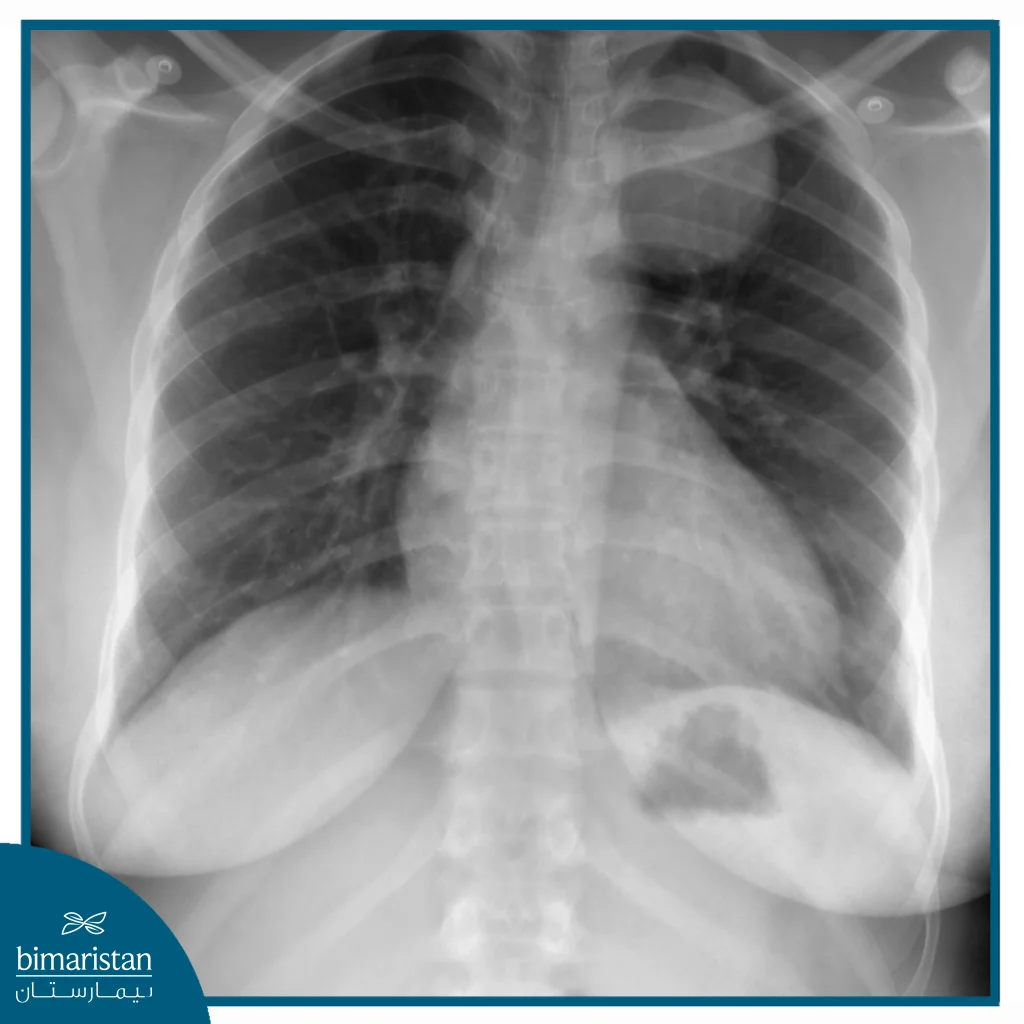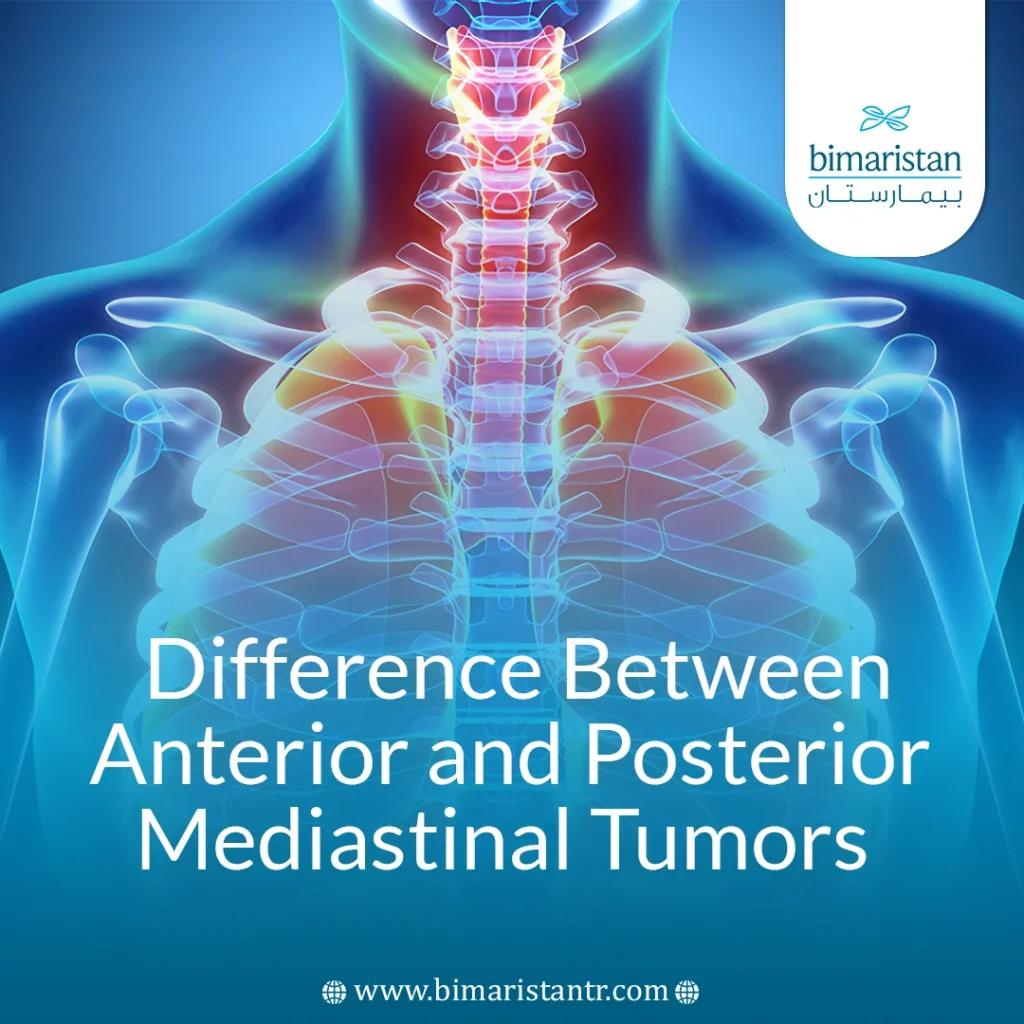The mediastinum is the central space in the chest, located between the lungs, and is divided into anterior, middle, and posterior mediastina. It contains vital organs such as the heart, esophagus, and lymph nodes, and the pattern of tumors varies according to location. Understanding the difference between anterior and posterior mediastinal tumors is important to guide diagnosis and treatment. Some tumors are malignant and require early intervention, as early detection is a key factor in improving clinical outcomes and reducing complications, especially in cases that do not show clear symptoms in the early stages.
What is the mediastinum, and how is it divided anatomically?
The mediastinum is the central anatomical space in the thoracic cavity, located between the lungs, extending from the sternum in front to the spine in back and from the upper thoracic inlet to the diaphragm below. It contains the heart, pericardium, great vessels, trachea, esophagus, thymus, and lymph nodes, and is divided into three main sections:
- Anterior mediastinum: Located in front of the heart and includes the thymus gland and adipose tissue.
- Middle mediastinum: Contains the heart, pericardium, pulmonary vessels, and trachea.
- Posterior mediastinum: Includes the esophagus, descending aorta, and nerve elements.
Each section of the mediastinum contains certain organs and is therefore prone to different tumors.
Tumors of the anterior mediastinum
His tumor is one of the most common chest tumors and is characterized by a variety of histological patterns depending on the composition of the compartment.
Location and the most important organs
Tumors of the anterior mediastinum are located in the space between the sternum and the pericardium and include the area containing the thymus as well as lymphatic vessels and adipose tissue. These structures are the main source of tumors in this section.
The most common tumors
Thymomas are the most common tumors, followed by lymphomas and germ cell tumors, and an enlarged thymus or migrating thyroid tissue may also be seen in some cases of Graves’ disease.
Symptoms
Symptoms appear as a result of the tumor mass pressing on neighboring structures and include chest pain, coughing, shortness of breath, difficulty swallowing, or obstructive symptoms such as superior vena cava syndrome in advanced cases.
Tumors of the posterior mediastinum
Tumors of the posterior mediastinum are different in nature and present with varying symptoms depending on their size and location, and must be recognized in order to distinguish the difference between anterior and posterior mediastinal tumors.
Location and the most important members
Tumors of the posterior mediastinum are located in the space behind the trachea and esophagus and extend to the spine. This section of the mediastinum contains the nerves, esophagus, descending aorta, nerve nodes, and surrounding fatty tissue.
The most common tumors
Neurogenic tumors are the most common tumors at this site and include Schwann tumors, neuroectodermal tumors, lymphomas, esophageal cysts, and other rare tumors such as sebaceous and osteoid tumors.
Symptoms
These tumors are often silent in the early stages and are discovered by chance or when obvious symptoms appear, such as pain in the back or between the shoulders. Patients may experience difficulty swallowing or neurological symptoms in advanced cases due to the tumor’s pressure on nearby nerves.
The difference between anterior and posterior mediastinal tumors in diagnosis
Distinguishing the difference between anterior and posterior mediastinal tumors is necessary in order to direct the appropriate treatment. For example, some mediastinal tumors may be misdiagnosed as lung cancer due to the convergence of symptoms and location, which requires accuracy in distinguishing them by radiological diagnosis. One of the most important steps followed is:
Radiography
- Computerized tomography (CT): Used to determine the exact size, shape, and location of a tumor.
- Magnetic resonance imaging (MRI): Especially useful for tumors of the posterior mediastinum to assess positioning relative to the nerves and spine.
Location and internal components of the tumor
Tumors of the anterior mediastinum are often associated with the thymus gland or lymphatic tissue, while tumors of the posterior mediastinum are usually neurological or spine-related, a distinction that guides diagnostic testing and treatment options.
Biopsy
In some cases, a biopsy is performed to determine the exact histological type, especially in lymphomas or germinomas, and thus helps us distinguish between tumors of the anterior and posterior mediastinum.
Pulmonary function testing and lab tests
They are used to assess the impact on the respiratory system and provide general diagnostic support for the condition.

How is each type treated?
Treatment for anterior and posterior mediastinal tumors varies depending on the type, location, and size of the tumor.
Treatment of anterior mediastinal tumors
Surgery is the primary treatment for anterior mediastinal tumors, and special emphasis is placed on removing the entire thymoma to reduce the risk of relapse. In some cases, complementary treatment depends on the type of tumor, where chemotherapy or radiation is used to control tumors that are malignant or difficult to remove surgically.
Treatment of posterior mediastinal tumors
In tumors of the posterior mediastinum, surgery is the main option, especially for neural tumors that may cause pressure symptoms or neurological complications, while for small benign tumors, it is preferable to monitor them and periodic follow-up using medical imaging without immediate surgical intervention unless there are changes in their size or nature.
Distinguishing the difference between anterior and posterior mediastinal tumors is essential for an accurate diagnosis and effective treatment planning. Anatomical location and radiographic features help guide clinical suspicion towards the type of tumor, with CT and MRI being key tools in this evaluation. Early diagnosis, along with regular follow-up, can help prevent complications and improve the chances of recovery and long-term clinical outcomes.
Sources:
- National Center for Biotechnology Information. (2020). Colon cancer: Surgical management. In R. A. Weinberg (Ed.), StatPearls. StatPearls Publishing.
- MedlinePlus. (2023). Colon cancer. U.S. National Library of Medicine.

